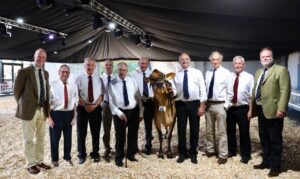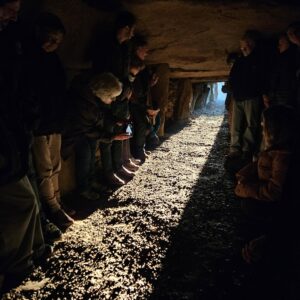Recently retired Victoria College head of history ANDY GILSON is in the process of writing a book on faming in Jersey during the Occupation. In the second of two preview article, expanded from his contribution to the summer 2015 issue of RURAL – Jersey Country Life, he discusses dairy farming during the Occupation
ON THE EDGE OF A VOLCANO
THE German Occupation led to interference in all aspects of Island agriculture. The last article demonstrated that the German authorities, through Field Command 515, laid down the rules. The Superior Council, along with the Department of Agriculture, their inspectors, and the Jersey farmer, had no option but comply with endless agricultural orders, demand for statistics and unrelenting and inexorable bureaucratic control.
This interference, however, did not ultimately affect the integrity of the Jersey cattle breed.
With a very small number of exceptions, the Germans left the Jersey under the auspices of the Royal Jersey Agricultural and Horticultural Society, which, together with the Jersey Farmers Union, ran an ‘Emergency Executive Committee’ throughout the Occupation comprising a number of important cattle sub committees which safeguarded the Jersey breed. The records demonstrate a remarkable achievement of local ingenuity among the farming community and the Department of Agriculture. This evolved into a unique form of opposition to the Occupation.
The Germans as they conquered Europe demonstrated a natural propensity for acquiring the valuable asserts of occupied countries. It is surprising, therefore, that the Germans did not extract the unique potential of the Jersey and transfer back to Germany in large numbers the best of pedigree stock. In addition, the Germans never come forward with ‘improvement’ schemes of the Jersey by the infusion of continental strains. It is evident that this may have well occurred had the Germans not suffered a series of military setbacks after 1942. A prominent member of the RJA during the Occupation wrote, ‘…. the cattle on the Island lived on the edge of a volcano’.
In the spring of 1940 a far sighted order arranged for a register of Jersey cattle for slaughter to be set up, regulated by the RJA&HS. A communication of 7 January 1941, intended for the farming community, from KVR Dr Egon Pelz (the officer in charge of agriculture for Field Command 515), described the German agricultural plan for Jersey. It was made clear that the Island breed would be protected. Meat would be imported from La Manche département in order that Island cattle need not be slaughtered. The effect of this non-slaughter policy would lead to an increase in milk and butter and allow for a greater quantity of manure to be obtained.
The prospect, however, that Jersey cattle could be slaughtered became a real cause of concern among the local population, so much so, that the Superior Council on 10 May 1941 made an Island-wide pronouncement that, ‘in order to set at rest any doubts which have arisen as the maintenance of the Island’s milk supply, the Superior Council desires it to be known that although local cattle are being slaughtered at the Abattoirs in order to augment supplies of meat, strict instructions have been issued to the States Veterinary Surgeon not to permit the slaughter of any animal unless he is satisfied that such slaughter will not in any way prejudice the Island’s milk supply in the future’.
The prospect, however, that Jersey cattle could be slaughtered became a real cause of concern among the local population Therefore up to October 1941, although cattle were obtainable from France, the butchery of Jersey cattle was only needed to supplement these importations of meat. The end result was that by November 1942 a considerable number of barren heifers and unproductive cows had been culled.
Dr Egon Pelz made it clear that milk and butter was the fundamental requirement from the Jersey. By December 1941, the Department of Agriculture ordered, that to divert milk to the local population, only a very small number of calves, including two or three bull calves would be allowed. The RJA&HS appointed a ‘Selection Committee’ and to 1945 carried out rigorous inspections using a ‘points system’ to select high quality calves and maintain the pedigree.
In 1943 a definite change of policy was revealed by the German authorities. The civilian population was to immediately be dependent upon local cattle to obtain meat. A ‘Cattle Slaughter Executive Committee’ was established by the Department of Agriculture comprising the leading dairy farmers of both the RJA and JFU. Each parish farmer was ordered to provide cattle for slaughter in proportion to its population and the number of head required that week. This selection, although not popular with many farmers, was fairly administered and worked extremely satisfactorily until 18 December 1944, after which the German authorities made a second demand requiring 7 tons of meat a week. In order to feed the local island population and comply with the German order, up to 60 cattle a week would be required. Again in each parish a ‘Collecting Committee’ was set up overseen by the Emergency Executive of both farming organizations.
Between 18 December 1944 and 5 May 1945, 1,000 head of cattle were slaughtered equating to approximately 40 a week. In addition, the Germans commandeered a further 200 cattle that were sent to Guernsey, of which 100 ended up in Alderney. It is certain that had the Occupation continued for several more months, Jersey would have been in danger of losing many pedigree herds.
The control of milk from July 1940 was an important policy of the Occupiers. Collections of milk from farms were centralised by four dairies and farmers were forbidden to sell milk or butter. Contemporary documents testify that farmers faced immense problems in maintaining a constant milk supply. The difficulty of maintaining hygiene, keeping milk cool, constant changes in milk collection times, adhering to a German time zone, the threat of foot and mouth and periodic outbreaks of earble fly infestation. One pot of bad milk could contaminate a lorry load collection.
In 1942 the Germans, believing that farmers were not sending in all their milk, put into operation 25 milk inspectors to oversee farms. They checked milking with the herd’s milk records. A constant battle of wits ensued between the inspectors and farmers. Varied and devious explanations as to the reason why cows were not producing the required level were devised. One farmer often milked his cows at 4 am, two hours early and before the inspector arrived.
In Grouville, Arthur McGugan and his brother, each had their own cows to milk. When the inspector arrived they would simply exchange the cows they milked, as each cow would only lactate fully for the brother that it was used to.
The tail end of the Occupation saw the Germans demand greater quantities of milk. Severe threats were made if the milk were not to be forthcoming. On 30 April 1945, Touzel Brée, head of the Department of Agriculture, sent a letter to every dairy farmer in Jersey extoling them to increase their milk supply. It was a remarkable achievement that the Jersey farmer and his herd, for almost the entire occupation, produced enough fresh milk for every child in the Island to receive a daily allowance.
Jersey was most probably the only country in German occupied Europe where this was accomplished. It took five years of Occupation, D – Day, the second front invasion of Europe, and an Admiral willing to fight to the last man, to stop Jersey children receiving their milk allowance. Unfortunately this fact seemed to have been forgotten by the States of Jersey when in December 2010 it voted to stop milk being distributed to Island children.
*With thanks to Alan Allix for allowing access to his personal research, archive material and photographic collection on Field Command 515 and the Occupation.




